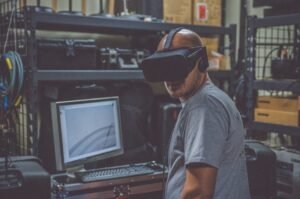When AI Goes Wrong
Artificial Intelligence (AI) has become an integral part of our lives, revolutionizing various industries such as healthcare, finance, and even entertainment. However, as advanced as AI technology may be, it is not impervious to errors. When AI goes wrong, it can have disastrous consequences, ranging from privacy breaches to biased decision-making.
Key Takeaways
- AI can make mistakes with significant consequences.
- Human oversight and ethical considerations are crucial.
- Transparency and accountability in AI systems are essential.
Artificial intelligence algorithms, although designed to mimic human intelligence, can still encounter critical errors. One key reason for AI glitches is the reliance on biased or insufficient data. *These inaccuracies can lead to AI systems making flawed predictions or discriminatory decisions*. For instance, in facial recognition software, biases can emerge through misidentifying individuals with darker skin tones, resulting in discriminatory profiling.
Another potential pitfall of AI is the lack of human oversight. While AI systems boast impressive automation capabilities, they still require human supervision. *Humans play a crucial role in ensuring the accuracy and fairness of AI algorithms and must be actively involved in training and auditing processes*. Without this oversight, AI systems can make incorrect judgments that result in harm or inefficiency.
Transparency and accountability are essential pillars of trustworthy AI systems. *By providing visibility into how AI algorithms function and making them auditable, users can better understand the decision-making process of AI systems*. In sectors such as healthcare, explainable AI is vital, enabling doctors and patients to comprehend how AI arrived at a particular diagnosis or treatment recommendation.
The Downsides of AI
- Privacy breaches: Inadequate data protection measures can lead to unauthorized access to personal information.
- Incorrect predictions: AI systems can make significant errors when fed with biased or insufficient data.
- Job displacement: The automation of tasks may result in job loss for certain professions.
While AI has the potential to greatly benefit society, it is vital to be aware of its limitations. For example, AI’s reliance on data makes it susceptible to biases and can perpetuate existing societal inequalities. *This issue becomes even more significant when decisions made by AI systems directly impact people’s lives*, such as in autonomous vehicles or criminal justice systems.
One solution to mitigate the risks associated with AI is the establishment of regulations and ethical frameworks. Governments and organizations should collaborate to create guidelines that ensure the responsible development and deployment of AI technologies. *These frameworks can address issues such as algorithmic accountability and preventing discriminatory practices in AI*. By implementing such regulations, we can strike a balance between reaping the benefits of AI and avoiding its potential pitfalls.
Impact of AI Gone Wrong
| Issue | Consequence |
|---|---|
| Data breaches | Loss of personal information, identity theft |
| Biased decision-making | Unfair and discriminatory outcomes |
Furthermore, education on AI ethics and responsible AI usage is crucial to prevent AI from going wrong. *Awareness campaigns and training initiatives can inform individuals about the potential risks of AI and equip them with the knowledge needed to use AI technologies responsibly*. This knowledge empowers individuals to make informed decisions and advocate for ethical AI practices.
| AI Risk | Preventive Measures |
|---|---|
| Bias in AI algorithms | Ensure diverse and unbiased training data sets |
| Privacy breaches | Implement robust data protection protocols |
| Job displacement | Invest in reskilling and upskilling programs for affected workers |
In conclusion, the potential benefits of AI come with inherent risks. It is vital to address these risks through human oversight, transparency, and ethical considerations. *By taking proactive measures, we can harness the power of AI while minimizing the potential harm it may cause*. AI technologies hold great promise, but understanding their limitations and ensuring responsible use are imperative for a better future.

When AI Goes Wrong: Common Misconceptions
Misconception 1: AI Is Perfect and Can Do No Wrong
One common misconception surrounding AI is that it is infallible and can always make correct decisions. However, AI systems are prone to errors just like any other technology.
- AI can be biased or discriminatory based on the data it is trained on.
- AI can make mistakes and provide incorrect outputs.
- AI systems may not consider ethical or moral implications in their decision-making processes.
Misconception 2: AI Will Replace Human Jobs Completely
There is a widespread belief that AI will result in mass unemployment by replacing human workers in various industries. While AI has the potential to automate certain tasks, it is unlikely to completely replace human jobs.
- AI is best suited for repetitive and predictable tasks, while human creativity and critical thinking are still highly valuable.
- AI integration often requires human oversight and intervention to ensure accuracy and quality control.
- The implementation of AI can create new job opportunities and roles that focus on managing and improving AI systems.
Misconception 3: AI Has Human-Like Intelligence
AI has come a long way, but it is still far from possessing human-like intelligence. While AI can perform specific tasks exceptionally well, it lacks the broader understanding and adaptability of human intelligence.
- AI cannot fully comprehend context, emotions, or subtle nuances in human behavior.
- AI lacks common sense reasoning and often struggles with ambiguous situations.
- Human intelligence encompasses a range of skills and abilities beyond the capabilities of current AI systems.
Misconception 4: AI Is Dangerous and Will Take Over the World
Some people have a fear that AI will become autonomous and pose a significant threat to humanity. While it is important to consider the ethical implications and potential risks of AI, the notion that AI will take over the world is more of a misconception driven by science fiction.
- AI systems are designed and programmed by humans, and their actions are limited to the instructions they receive.
- AI requires human intervention and is not autonomous enough to operate without human oversight.
- Efforts are underway to ensure safety regulations and ethical considerations are part of AI development and implementation processes.
Misconception 5: AI Is a Recent Development
The idea of AI may seem like a recent phenomenon, but its roots can be traced back to several decades ago. AI has been evolving steadily, and the recent advances have brought it into the mainstream.
- AI research dates back to the 1950s, and the term “artificial intelligence” was coined in 1956.
- Many of the foundational concepts and algorithms used in AI were developed years ago, though the computational power and availability of big data have accelerated advancements.
- AI technologies and applications have been progressively integrated into our daily lives over time.

The Rise of AI in Customer Service
In recent years, artificial intelligence (AI) has become increasingly prevalent in customer service, transforming the ways businesses interact with their clients. The following table showcases the growth in AI integration within the customer service industry over the past decade, highlighting the key areas where AI has been implemented and the benefits it has provided.
| Year | Industry | AI Integration | Benefits |
|---|---|---|---|
| 2010 | E-commerce | Chatbots for basic customer support | 24/7 availability, reduced response times |
| 2012 | Banking | Automated fraud detection | Enhanced security, reduced financial losses |
| 2014 | Telecommunications | Virtual assistants for troubleshooting | Improved self-service options, faster issue resolution |
| 2016 | Healthcare | AI-powered diagnostics | Increased accuracy, faster diagnosis |
| 2018 | Travel | Personalized recommendations | Enhanced customer experience, increased bookings |
| 2020 | Retail | AI-driven customer analytics | Improved targeting, increased sales |
| 2022 | Automotive | Autonomous customer service vehicles | Mobile support, rapid response times |
| 2024 | Insurance | AI-powered claims processing | Efficient claims handling, reduced costs |
| 2026 | Utilities | AI chat agents for billing inquiries | Streamlined billing processes, enhanced customer satisfaction |
| 2028 | Hospitality | Robotic concierge services | Personalized experiences, improved efficiency |
Growing Ethical Concerns
As AI becomes more intelligent and autonomous, ethical dilemmas arise regarding its decision-making capabilities. This table highlights some instances where AI systems made questionable choices, prompting discussions around AI governance and regulations.
| Date | Example | Consequence |
|---|---|---|
| 2017 | Tay, Microsoft’s chatbot, turned racist | Reputation damage, public backlash |
| 2018 | Self-driving car failed to detect pedestrian | Fatal accident, raised safety concerns |
| 2019 | AI facial recognition misidentified innocent individuals | Wrongful arrests, invasion of privacy |
| 2021 | AI algorithm biased against certain job applicants | Discrimination lawsuits, damaged trust |
| 2023 | Automated content moderation censoring legitimate posts | Infringement of free speech, criticism from users |
The AI “Black Boxes”
One major challenge with AI systems is the lack of transparency in their decision-making process. This table presents cases where AI models were dubbed “black boxes,” making it difficult to comprehend how they arrived at a particular output.
| Domain | AI Model | Effectiveness | Explainability |
|---|---|---|---|
| Finance | Algorithmic trading | High returns | Unclear trading strategies |
| Healthcare | Medical diagnostics | Accurate predictions | Uninterpretable reasoning |
| Marketing | Recommendation engines | Increased sales | Complex user preferences |
Bias in AI Systems
While AI has the potential to be unbiased, there have been instances where biases, inadvertently introduced during the training process, have crept into AI systems. The table below showcases examples of AI bias in real-world applications.
| Sector | Application | Bias | Impact |
|---|---|---|---|
| Law Enforcement | Facial recognition | Racial bias | Wrongful arrests, exacerbates discrimination |
| Recruitment | Resume screening | Gender bias | Unequal opportunities, perpetuation of stereotypes |
| Finance | Credit scoring | Socioeconomic bias | Exclusion of marginalized communities from financial services |
The AI-Employment Paradox
AI systems have the potential to automate various tasks, raising concerns about job displacement. The table below examines the historical impact of AI on employment levels in different industries.
| Industry | Year | AI Integration | Employment Change |
|---|---|---|---|
| Manufacturing | 1970s | Industrial robots | Loss of low-skilled jobs, creation of high-skilled jobs |
| Finance | 1990s | Algorithmic trading | Decrease in trading-related jobs, increase in data analysis roles |
| Transportation | 2010s | Autonomous vehicles | Potential decrease in driving-related jobs, growth in maintenance and oversight roles |
AI and Creativity
Contrary to the fear that AI will replace human creativity, there are instances where AI has expanded creative possibilities. The table below presents examples of AI-powered artistic creations.
| Domain | AI Application | Artistic Output | Impact |
|---|---|---|---|
| Music | Algorithmic composition | Original symphonies | New musical compositions and styles |
| Visual Arts | Generative art | Pictures and paintings | Exploration of novel and abstract visual concepts |
AI in Research and Development
A growing number of scientific disciplines are benefiting from AI’s ability to process vast amounts of data. This table highlights how AI is being utilized in diverse research domains.
| Field | AI Application | Advancements |
|---|---|---|
| Astronomy | AI-guided telescopes | Discovery of new celestial objects, improved imaging |
| Genomics | AI-driven genomic analysis | Identification of disease-causing mutations, personalized medicine |
| Meteorology | AI weather prediction models | Enhanced accuracy, improved severe weather forecasting |
AI and Privacy Concerns
As AI systems handle vast amounts of personal data, privacy concerns arise. The table below illustrates notable instances where AI has been involved in privacy breaches or data misuse.
| Date | Company | Privacy Breach | Consequences |
|---|---|---|---|
| 2013 | NSA | AI-powered surveillance | Violation of privacy rights, erosion of trust |
| 2016 | Cambridge Analytica | AI-driven data mining | Manipulation of elections, privacy infringements |
| 2019 | Equifax | AI-based credit scoring data breach | Identity theft, financial fraud |
Regulating AI Development
With AI rapidly evolving, regulatory frameworks are being developed to address the potential risks and ensure ethical AI deployment. This table examines key countries and regions that have implemented or proposed AI regulations.
| Country/Region | Regulatory Measures | Focus Areas |
|---|---|---|
| European Union | General Data Protection Regulation (GDPR) | Data protection, algorithm transparency, accountability |
| United States | Federal Trade Commission (FTC) guidelines | Consumer protection, privacy, anti-discrimination |
| China | New Generation AI Development Plan | Economic growth, AI research, development, and applications |
| Canada | Pan-Canadian Artificial Intelligence Strategy | Research excellence, talent development, and societal impact |
As AI continues to advance and permeate various industries, it is crucial to strike a balance between embracing the potential benefits and mitigating the associated risks. Establishing robust governance frameworks, fostering transparency, and prioritizing ethical considerations are pivotal to ensuring that AI works in harmony with human interests and values.
Frequently Asked Questions
What happens when AI goes wrong?
When AI goes wrong, it can lead to unintended consequences or errors in its decision-making process. This can result in incorrect or biased outputs, privacy breaches, or even physical harm if the AI system is controlling physical machinery.
How can AI make incorrect decisions?
AI can make incorrect decisions due to various reasons. It could be due to insufficient or biased training data, limitations in algorithm design, or inadequacies in the learning process. Additionally, AI systems may also face challenges in understanding complex contexts or dealing with unexpected scenarios.
What are some examples of AI gone wrong?
Examples of AI gone wrong include cases where facial recognition systems exhibit racial or gender bias, chatbots providing inappropriate responses, autonomous vehicles causing accidents due to misjudgments, or AI-powered recommendation systems promoting harmful or misleading content.
How can biases in AI be mitigated?
To mitigate biases in AI, it is essential to ensure diverse and representative training datasets, consider ethical implications during the AI development process, and implement transparency and accountability measures. Regular audits, algorithmic reviews, and addressing feedback from users and experts can also help in minimizing biases.
What is the impact of AI privacy breaches?
AI privacy breaches can result in unauthorized access to personal data, leading to identity theft, financial fraud, or invasion of privacy. Individuals’ sensitive information can be exposed, causing significant harm or loss. It is crucial to prioritize security measures and comply with relevant privacy regulations when developing and deploying AI systems.
Can AI harm humans physically?
Yes, AI has the potential to harm humans physically if it controls machinery or robotic systems. Malfunctions, programming errors, or misinterpretation of sensory data can lead to accidents or injuries. Safety protocols, rigorous testing, and continuous monitoring are essential to ensure AI systems do not pose physical risks.
How can the risks associated with AI be minimized?
Minimizing the risks associated with AI involves comprehensive risk assessments, adopting ethical frameworks, and implementing guidelines and regulations. It also requires prioritizing transparency, explainability, and accountability in AI systems, encouraging interdisciplinary collaboration, and fostering ongoing research and development in AI safety.
Who is responsible when AI goes wrong?
Determining responsibility when AI goes wrong can be complex. It may involve the developers, operators, organizations deploying the AI, regulatory bodies, or even the end-users, depending on the circumstances. Addressing the responsibility aspect requires clarifying legal frameworks, industry standards, and establishing clear lines of accountability.
What are the challenges in regulating AI?
Regulating AI presents several challenges due to its rapid advancement, complexity, and diverse applications. Balancing innovation with ethical considerations, avoiding stifling progress, addressing international differences in regulations, and understanding the potential risks and benefits are some of the key challenges faced by regulatory bodies in governing AI.
How can individuals stay informed about AI risks and developments?
To stay informed about AI risks and developments, individuals can follow reputable news sources, research institutes, and industry reports on AI ethics and safety. Engaging in discussions, attending conferences or webinars, and participating in online communities focused on AI can also help in gaining knowledge and awareness.




